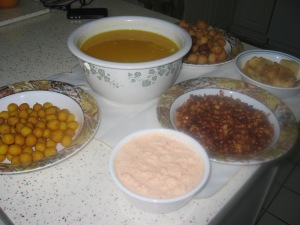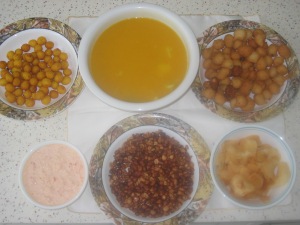Over the past few weeks, I have had a lot of requests from family and friends to share with you my recipe of what is termed the “Zanzibar mix”.
The mix as I shall be calling it from hereon, is a combination of chana bateta, dal bhajia, batatawada and cassava chips, peanuts, garnished with nariyal chutney (see previous post).
In our household this used to be on the menu most weekends. The great thing about this dish is that each person has to create their own “mix” from the several items provided so each and every bowl of mix will vary slightly in taste even though the same ingredients are used. Start to fill your bowl with boiled cubed potatoes, the chickpeas (grams) cooked in the gravy, then proceed to add the mini dal bhajias, batata wadas and top up with the Nariyal chutney, mogo chips and fried peanuts. You may want to add chilli powder, more lemon/lime etc the creation of this taste sensation is entirely yours. You decide what flavours you like most and fill up your plate accordingly.
In Tanzania, there are some very popular vendors selling their version of the “mix” some made with coconut milk, some using boiled peanuts and potator crisps etc. I think the name “mix” was given to it because of the obvious method of presentation; a mixture of various foods. I’m thinking that the vendors that sold chana bateta, dal bhajia, bateta wadas must have decided to use up all these items, add some sauces, and serve it up and thus this dish was born. An experiment that was sucessful and now a popular brunch menu. In Mwanza, my brother has “mix for his brunch on most days and I remember in Dar, people queue up for the famous Akhada Mix everyday.
As usual, I have added my own twist to this dish and I hope that you will enjoy it as much as all of our friends and family do. It is a party favourite and I am sure you will be asked to share the recipe over and over again
There is quite a bit of preparation to do beforehand for the mix bit it really is worth the extra effort..
Firstly, soak your dal for the mini dal bhajia and the black gram ( see previous post for bhajia) the night before. Also ensure you have the ingredients for the Nariyal Chutney and follow previously posted recipe for this.
Aside from the above, you will need a packet of mogo chips, and peanuts as well as enough oil for deep frying the bhajia, batetawada and peanuts.
Thus your main ingredient list should be:
oil for deep frying
black grams (soaked overnight and pressure cooked)
potatoes (steamed)
split black eyed beans (for bhajia) -soaked overnight and then ground
freshly grated coconut
white flour
gram flour
lime/lemon juice
peanuts
mogochips
Other ingredients from your pantry – turmeric, salt, chilli powder, citric acid.
Chana Bateta
1/2 cup whole gram (kala chana or brown chickpeas). Soaked overnight in 3 cups water before you plan to make the mix
2 cups water (appx) for boiling
3/4 tea sp salt
4 medium / large potatoes
Pressure cook gharm & potatoes. (you may wish to do these separately as both have different cooking times)
Set on the side.
Use 3 of the cooked potatoes for mix ( cut in to small cubes)
Mash 1 boiled potato for making batetawada.






